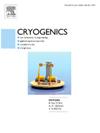基于电容体层析成像的球形容器低温两相流成像研究
IF 2.1
3区 工程技术
Q3 PHYSICS, APPLIED
引用次数: 0
摘要
基于数值模拟的低温流体输运过程三维两相结构测量研究在航空航天领域具有重要的应用价值。基于电容体层析成像(ECVT)技术,针对低温球形容器设计了32电极、16电极和8电极三种不同电极数的ECVT传感器。给出了ECVT灵敏度计算的详细理论推导。通过数值模拟得到了三种类型的灵敏度场分布和图像重建质量。采用液氮(LN2)和液氢(LH2)两种低温工作介质评价成像质量。结果表明,32电极传感器具有均匀的灵敏度场分布,具有良好的图像重建精度。此外,还比较了LBP、Landweber、Tikhonov和共轭梯度四种图像重建算法的性能。在分层流模式下,Landweber显示出最高的图像重建精度,质量守恒误差为<; 10%,质心定位偏差最小,而共轭梯度显示出更高的效率,具有高精度的气泡流成像。Tikhonov被证明适用于气泡流,而LBP则有效地用作初始猜测。研究了网格数量对计算效率和重建精度的影响。LN2-VN2和LH2-VH2流的成像一致性证实了ECVT在低温介质中的适应性。研究结果为ECVT技术在低温两相流监测中的应用提供了理论优化方法和应用潜力。本文章由计算机程序翻译,如有差异,请以英文原文为准。
Research on cryogenic two-phase flow imaging of spherical container based on electrical capacitive volume tomography
Numerical simulation-based research on measuring the three-dimensional two-phase structure of cryogenic fluid transport processes holds significant value in aerospace applications. Based on electrical capacitance volume tomography (ECVT) technology, three types of ECVT sensors with varying electrode numbers, namely 32-electrode, 16-electrode, and 8-electrode, are designed for cryogenic spherical containers. The detailed theoretical derivation of ECVT sensitivity calculation is given. Numerical simulation is conducted to obtain the sensitivity field distribution and image reconstruction quality for the three types. Two cryogenic working mediums, liquid nitrogen (LN2) and liquid hydrogen (LH2), are used to evaluate the imaging quality. The results indicate that the 32-electrode sensor achieves a uniform sensitivity field distribution and demonstrates excellent image reconstruction accuracy. Furthermore, a performance comparison is made between the four image reconstruction algorithms: LBP, Landweber, Tikhonov, and Conjugate Gradient. Under stratified flow patterns, Landweber exhibits the highest image reconstruction accuracy with <10 % mass conservation error and minimal centroid localization deviation, while Conjugate Gradient demonstrates superior efficiency for bubble flow imaging with high precision. Tikhonov proves suitable for bubble flows, whereas LBP serves effectively as an initial guess. The influence of mesh quantity on computational efficiency and reconstruction accuracy is also studied. Imaging consistency between LN2-VN2 and LH2-VH2 flows confirms ECVT’s adaptability across cryogenic media. The results provide the theoretical optimization method and application potential of ECVT technology for monitoring cryogenic two-phase flows.
求助全文
通过发布文献求助,成功后即可免费获取论文全文。
去求助
来源期刊

Cryogenics
物理-热力学
CiteScore
3.80
自引率
9.50%
发文量
0
审稿时长
2.1 months
期刊介绍:
Cryogenics is the world''s leading journal focusing on all aspects of cryoengineering and cryogenics. Papers published in Cryogenics cover a wide variety of subjects in low temperature engineering and research. Among the areas covered are:
- Applications of superconductivity: magnets, electronics, devices
- Superconductors and their properties
- Properties of materials: metals, alloys, composites, polymers, insulations
- New applications of cryogenic technology to processes, devices, machinery
- Refrigeration and liquefaction technology
- Thermodynamics
- Fluid properties and fluid mechanics
- Heat transfer
- Thermometry and measurement science
- Cryogenics in medicine
- Cryoelectronics
 求助内容:
求助内容: 应助结果提醒方式:
应助结果提醒方式:


